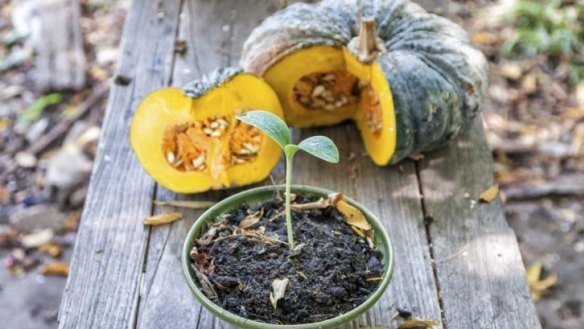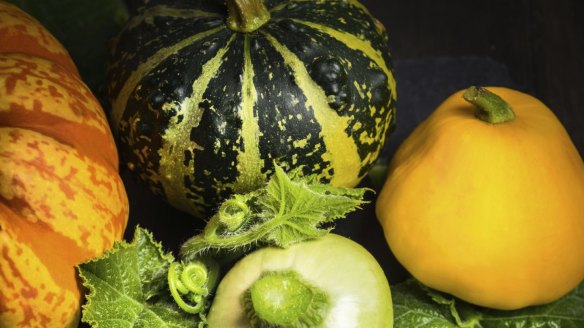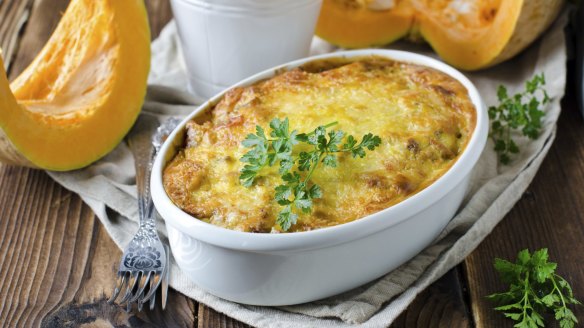Owen Pidgeon: Space and water key to growing best pumpkins in ACT region

Pumpkins are a big investment for the home gardener, in that they need lots of space, time and attention. However, the results can be very rewarding if you can invest well. Most vines will produce two or three good-sized pumpkins if the growing runs well. Some backyard gardeners have been able to produce much higher yields from one or two plants.
Now is the time to plant pumpkins in the cooler, temperate regions, as the danger of frosts is over and the soil temperatures are warming. You will need to allow four to five months for the growing cycle so it is time to get going, if you live in the cooler regions, such as Canberra.
I have often tried to get a head start with planting some seeds into small pots, but pumpkins do not like to be disturbed by transplanting, and planting seeds directly into the garden bed will often produce stronger, more vigorous plants.
Many people will have their own story of a most productive pumpkin vine growing out of a compost heap. The vine will have all the food that it will need and its roots can extend quickly to seek out more nutrients. If left to grow undisturbed and given regular waterings, a pumpkin plant growing out of the side of a compost heap can produce an amazing crop of big fruit.

The art is in replicating a compost heap on a small scale to provide a deep, rich, moisture-retentive soil. Pumpkins send out their roots in search of food and water, and they need copious amounts of both, especially when the flowers are forming and the fruit is beginning to set.
If you have lots of space, prepare one-metre circles in the shape of mounds. Dig out the centres down 40 to 50 centimetres deep and back fill some well-rotted cow, sheep or horse manure mixed with home compost. Cover with your topsoil and plant two or three seeds just two centimetres deep in each of three groupings across the circle. When the seeds germinate, remove the weakest ones and leave the strongest three or four plants to grow on.
Where you have limited space in the backyard, you can set up an inclined trellis with some timber beams lashed together on a back corner of the garden. The trailing vines can be trained up the frame. Long, thick bamboo poles would also do a fine job, as you just need to have strong supports for when the pumpkins are fully grown.
The pumpkin is indeed a sprawling, spreading plant, which can overrun your whole garden if you let it. You can limit the spread and encourage fruit formation by pinching out the growing tips when the main leader vines are extended. Of course, the smaller varieties are not as vigorous, so you may wish to limit your selection of varieties.
One other key point to note is the challenges of pollination. Each pumpkin plant will produce both male and female flowers, but they do not seem to co-ordinate well. The male flowers will always appear first and will often stay fresh for just one day before withering on the vine – not much time for pollination to take place. So do not be alarmed when no fruit appears after the first flowers.
Unless you have plenty of bees hovering around to do the pollination work, you might want to help out.
Once the female flowers begin to appear, with their bulbous base, you can assist the pollinating. In the early mornings, pick off a male flower, gently pull off its petals and gently brush the stalk with its pollen inside the female flower. Alternatively, take a soft, narrow paintbrush to first, catch the pollen in the male flower and then liberally dust it inside the female flower.
The butternut pumpkin will produce its crop in around 18 weeks and it requires a smaller area to grow. The skin is quite hard, so it will store well. One garden circle growing butternuts can provide your family with several for the winter months.
With small spaces, you can plant the bush variety called Golden Nugget. It is a quick grower and it takes up only the same space as a zucchini plant. Allow one square metre per plant and you will have a harvest of small, round ribbed pumpkins in just three months.
I am attracted to the two fine, Australian-bred pumpkins for the main cropping. Jarrahdale is a fine grey, ribbed pumpkin. It is easy to peel and its flesh is a beautiful deep orange colour. The Jarrahdale was bred in Western Australia and it will produce fruit that can weigh between six and eight kilograms. It does take 4½ months to produce its crop, but you can usually expect a good yield per plant. Our son Stephen harvested six per plant from his crop of Jarrahdales two years ago.
The Queensland blue is the other fine blue-grey skinned pumpkin with deep ribbing. Again, the fruit will take over four months to maturity but as the skin is thick and hard, you will have a wonderful long-lasting pumpkin for the winter months.
The Australian butter is an heirloom pumpkin with a deep tan skin and deep orange flesh. It grows more quickly than many other larger pumpkins. Its dense, deep-orange flesh makes it an excellent choice for baking. It is also a good keeper.
The Musquee de Provence is a lovely russet-brown ribbed pumpkin from the south of France. It produces a large fruit with very fine flavour. It stores well so is a good keeper for the winter months. Rouge Vif d'Etampes, otherwise known as the Cinderella pumpkin, is the other bright-orange skinned pumpkin that originated in France. It makes excellent, smooth pumpkin soup.
If you want to try growing some of the more unusual varieties of pumpkins, then consider some of the European pumpkins. There is the curiously shaped Turks Turban, with its stripes of orange, white and green. The salmon pink French heirloom Galeaux d'Eysines is covered by shell-like warts caused by variable levels of sugar as the fruit is maturing. The flesh of this pumpkin is sweet and moist so it can be used for both soups and for baking.
The Italian Marina di Chioggia is another knobbly, bumpy-skinned pumpkin. It is dark green to grey in colour and has sweet, rich deep-orange flesh, so is good for soups and for baking. It will keep for months.
Always wait to harvest your pumpkins until they are fully coloured and the stems begin to die off. Keep plenty of stem attached to the mature pumpkin and allow them to fully dry off in the sun before you store them.

Pumpkin and potato gratin
500g Dutch cream potatoes
700g pumpkin
1 large brown onion
4 sprigs of thyme, finely chopped
1 tsp cayenne pepper
3 garlic cloves, crushed
450 ml King Island cream
100g parmesan cheese
salt and black pepper
Preheat oven to 180C. Peel and then thinly slice the potatoes, pumpkin and onion.
Lightly grease a shallow baking dish. Place a layer of potato slices in the bottom of the dish and season with salt, pepper and a sprinkling of thyme. Then lay slices of pumpkin and onion on top and sprinkle with the cayenne pepper. Place another layer of potato and pumpkin on top and season with the salt, pepper and thyme. Scatter the crushed garlic across the top and then pour over the cream. Sprinkle with grated parmesan cheese.
Cover with a lid or foil and bake in the oven for 25-30 minutes. Test with a sharp knife to see if the vegetables have softened. When well cooked, remove the cover and bake for another 10-12 minutes to create a delicious crust on top. Serve with roasts or grilled fish.
This week in the garden
* Plant rows of cos and salad bowl lettuce, snow peas, bush and climbing beans.
* Plant out tomato, capsicum, chilli and eggplant seedlings into fresh ground to which you have added compost and organic fertilizer. Cover if low overnight temperatures are forecast.
* As well as planting out pumpkins, plant a selection of zucchinis and button squash in rows with plenty of compost dug into the garden bed.
* Mulch all new garden beds with sugar cane or pea straw mulch or broken lucerne hay to keep down weeds, assist with retaining moisture and cooling the soil.
* Check your fruit trees again for overladen branches; remove excess fruit to achieve quality results.
Owen Pidgeon runs the Loriendale Organic Orchard near Hall.
Restaurant reviews, news and the hottest openings served to your inbox.
Sign up